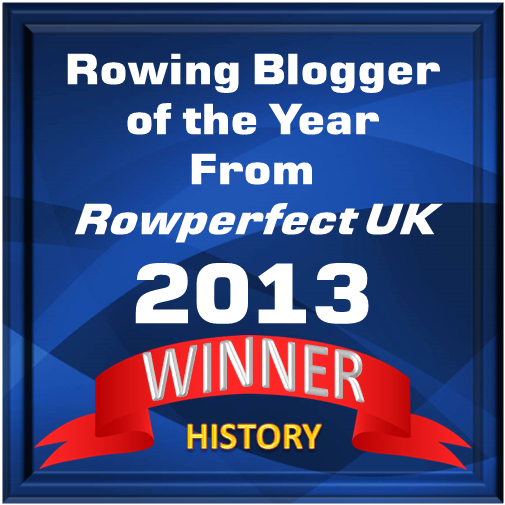Tuesday, May 14, 2013
A History of Collegiate Rowing in America
American rowing historians and rowing history buffs alike are very proud to announce that rowing – that is, the sport of rowing – was the first collegiate sport in the USA. Modelled after the famous Oxford and Cambridge Boat Race, which was raced the first time in 1829, the first Yale-Harvard race took place at Lake Winnipesaukee in 1852, with a victory for Harvard. In 1852, Harvard and Yale were not the only colleges with a rowing programme; Dartmouth started its programme in the beginning of the 1830s and students at Trinity College (Hartford, Conn.) formed a rowing club in 1849 (with Yale in 1843 and Harvard in 1844).
Although, rowing clubs were formed outside the colleges, it was collegiate rowing that was the firm base whereupon American rowing was resting for many years. It was, for example, college and university crews that represented the USA (and took the gold medals) in the eights in the Olympic Games from 1920 to 1956. Today there are more than 300 rowing programmes in America, Daniella K. Garran writes in her A History of Collegiate Rowing in America, which was published last autumn by Schiffer Publishing. As with most of Schiffer’s books, A History of Collegiate Rowing in America has a generous amount of beautiful illustrations, well, 142 to be exact, and with that it is a real coffee table book. With all these hundreds of rowing programmes widespread over the country, it is impossible to mention them all in a book close to 200 pages. Instead, it is the usual colleges and universities that are counted up with brief historic notes; in addition to those already mentioned: Bowdoin, Penn, Cornell, Princeton, Brown, Navy, Syracuse, Wisconsin, Washington, Cal-UW, Stanford, UCLA, to only mention a few. Garran, whose own rowing career was as a successful coxswain at Connecticut College in New London, Conn., in order to cover as much ground, or should I say, water, as possible has special chapters on famous collegiate rowing coaches (Courtney, Ebright, Gladstone, Nash, Parker, Teti, Ulbrickson, etc., etc.), Head races, Championships, Sprint races, Women’s rowing, Lightweight rowing, Conferences, and also regattas abroad: Henley in England and Canadian Henley, Under 23 Championships, World University Championships and, of course, the Olympics. Other text bites are rowing equipment and rowing term glossary.
The ambitious author has really tried to cover all the bases, not merely by giving us a lot of the history of the different clubs, coaches, crews, and lists of all rowing programmes, etc., she has also added ‘oddities’ that for non-rowers might seem peculiar: ‘shirt betting’ and ‘cox tossing’. Clearly, Garren’s work is meant to be a reference book for those high school students – rowers and non-rowers – who aspire to row at a college or university, but also to steer the post-collegiate student in the right direction when he or she just have to continue to mess around in boats after college graduation, at a club or on a high level as the World Championships or the Olympics.
A History of Collegiate Rowing in America is indeed a well-written book and with its many marvellous photographs, most of them in colour – personally I am happy to see some photographs from the National Rowing Hall of Fame in Mystic, Conn., – it is a grand looking book. However, I cannot help wishing for more interference from an editor. Some of the ‘chapters’ or sections are bits and pieces that now look thrown in at the back of the book in lack of better spots and meaning. I found the rowing songs and poems in the book tremendously interesting, except without any deeper descriptions or analysis of these texts, what is the point of publishing them?
I also wished that Garren and/or the publisher would have contacted one or all of the three renowned American rowing historians, Tom Weil, Bill Miller or Peter Mallory, for a quick read-through of the manuscript. I am sure they would have spotted some of the unfortunate historical mistakes and errors that have sneaked into the book. To mention some: Hiram Conibear, coach at University of Washington, did not die in a car accident, he died from falling down from a tree (Garren has it correct in one place of the book but wrong in another – the question still remains: was it a plum, an apple or a pear tree?); the Syracuse coach Gus Eriksen was not a native of Sweden, he was born in Seattle, but could speak Swedish because his parents came from the Swedish-speaking island of Åland, which belongs to Finland; the first Americans to race at Henley Royal Regatta where not from Columbia College in 1878, it was E. Smith of Atlanta RC (New York) in 1872 in the Diamonds; and R.C. Lehmann did not write his Rowing (1897) together with Bertram Fletcher Robinson, the later was the editor of the book (but C.M. Pitman and Guy Nickalls wrote a chapter each in the book). While Garren writes that ‘one cannot help but compare Doggett’s Coat and Badge [Race] to some of the long-storied cup races in American collegiate rowing or to centuries-long traditions such as the Harvard-Yale race’, I have to confess that I do have a hard time comparing any American amateur collegiate rowing race with an English sculling race for professionals which was rowed for the first time close to 70 years before the USA got its independence.
Whereas these historical hiccups are slightly irritating, the over-all view of this book is positive. No one can deny that Daniella Garran loves the sport of rowing and that she wants to share it with as many people as possible. I wish her luck in this endeavour.
Subscribe to:
Post Comments (Atom)













.jpg)

No comments:
Post a Comment